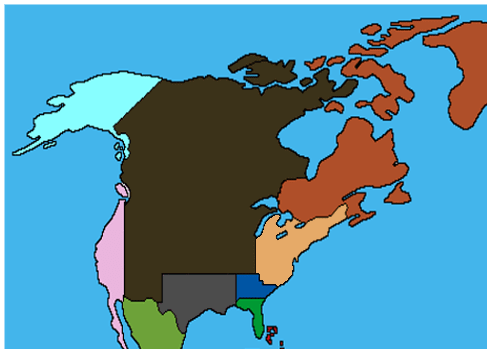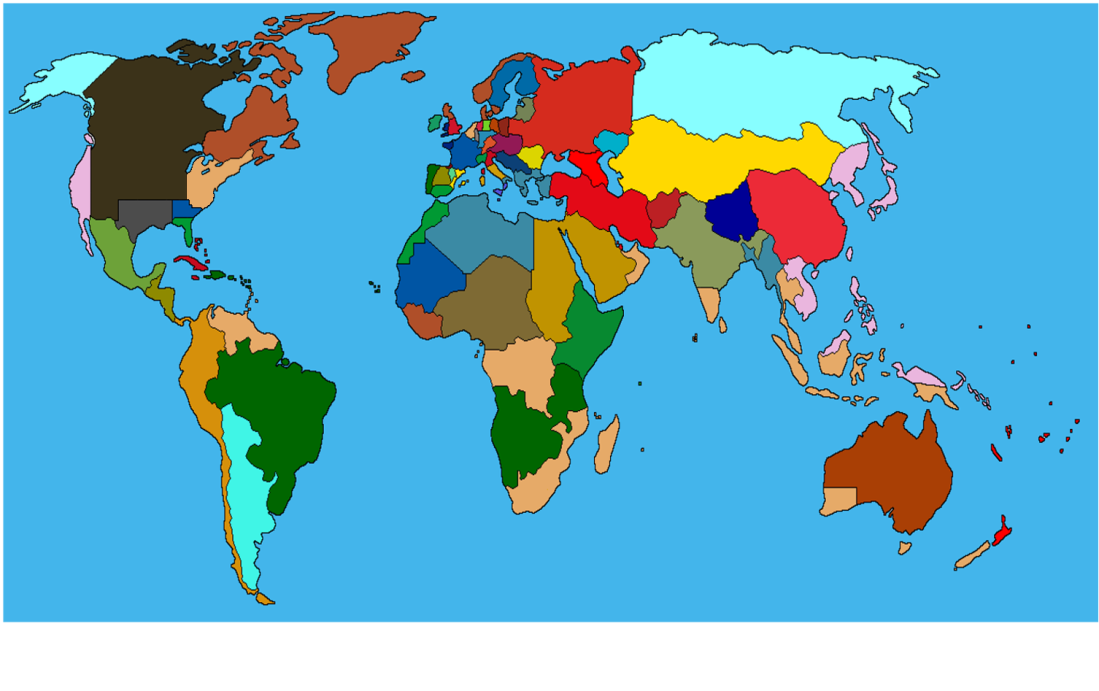 Exams are over!!! I am free from revision and stress for two months. Two months which I can spend working on my writing projects. The one which I want to talk about here is the most developed idea that I have, seeing as I’ve actually managed to put together a basic plan for it. I don’t know if this is to early to talk about the story, considering that it doesn’t really exist yet, but it might be fun to take a quick dive into the world of ‘Maddy’.
Exams are over!!! I am free from revision and stress for two months. Two months which I can spend working on my writing projects. The one which I want to talk about here is the most developed idea that I have, seeing as I’ve actually managed to put together a basic plan for it. I don’t know if this is to early to talk about the story, considering that it doesn’t really exist yet, but it might be fun to take a quick dive into the world of ‘Maddy’.
Overview
‘Maddy’ takes place in an alternate version of our Earth, around the year 1850. It’s different from our world in that the Viking settlements in America managed to remain there permanently, leading to much earlier colonisation of the Americans by European powers. This leads to friendly trading relationships between the Native Americans and the Europeans, with much less land being taken by the Europeans. Having land in America leads to a complete shift in power in Europe, with Denmark becoming much more powerful and dominating other Northern European powers.
By the time that the story is set the world is at the height of the colonial period. The European powers have colonies on all of the world’s continents, but have better relations with native populations due to their extended relationship with the Native Americans. Japan is joining the Europeans in its colonisation of the Pacific and surrounding areas. Empires are also growing in mainland Asia, with the resurgence of the Mongols and the reformation of a single China.
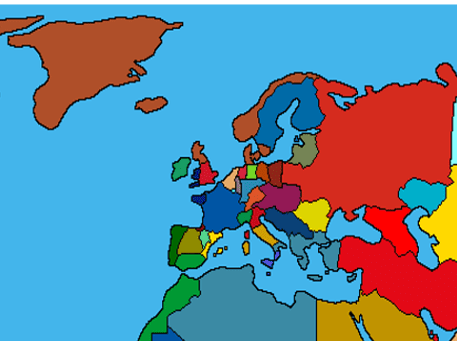
Europe
Europe is still incredibly fragmented, but in the process of uniting. Denmark owns the vast majority of Northern Europe, with: Scania, Norway, Iceland, Greenland, Pomerania ,and Scotland all being under its control. It definitely has military supremacy over Europe, with no single country being able to rival them. Germany, Italy, and Spain are all divided into many smaller states and kingdoms, with some of these states holding land outside of Europe, such as the Andalusian Dominican of Morocco.
There are some rising powers in Europe, all aiming to dominate the continent. Greece is in the process of building a Mediterranean empire, with it owning large parts of Magreb, parts of Italy, a number of islands, and a sizeable portion of Turkey. To its north, the Hungarian Empire is expanding into the fractured states, with its royal family, the Habsburgs, trying to return to their glory days. They were once the leaders of half of Europe, but the Dutch Revolt led to the collapse of the Spanish side of their dynasty, along with their international empire. In order to protect themselves from Greek and Hungarian Encroachments, several Slavic countries unified to form Yugoslavia.
Muscovy is the only real threat to the Hungarians. Despite loosing many of their holdings in the east, they have been expanding into Europe to compensate for these losses. The former Kingdoms of Ukraine and Poland have both been annexed into its empire, with a Polish puppet state being created in western Polish lands. The continued Muscovite expansion has caused the formation of the Baltic Republic, which is in a defensive alliance with the Republic of Sweden-Finland. These two countries are some of the few to permanently abolish their monarchies, instead being ruled by democratically-elected parliaments.
The majority of the democratic nations at this point is made up of France and their puppet states. The League of Republican States, France’s defensive alliance consists of the countries who France has ‘persuaded’ to become democracies. These nations consist of: Catalonia-Valencia, the Republic of Sardinia, Luxembourg, and the Rhenish Republic. They are committed to defending and spreading the French ideal of freedom, with their main goal being to unite Germany, Italy, and Spain as republics.
The Dutch and Portuguese empires are relatively small players in the European power struggle, with both of them being preoccupied with their global empires. They both own some land outside their homelands, with Portugal owning Galicia and the Dutch controlling Belgium, but both of these areas joined these countries voluntarily due to their cultural similarities. I’ll cover these empires in more detail as I cover each continent.
The final major part of Europe is the British Isles. Once a united nation, these isles have faced major turmoil in recent years. Scottish rebels allied themselves with the Danish, agreeing to become a semi-autonomous region of Denmark. The loss of Scotland was the first step in the collapse of the united isles. The Irish took this opportunity to rebel against their overlords, driving out the English in a series of wars. The final one of these, the Second Ulster War, ended with the English recognising Ireland as an independent nation as a part of the Treaty of Belfast.
This collapse reached its climax during the Republican Revolution in France. The English took the opportunity to invade the weakened France, but failed to account for internal issues. The three occupied Celtic countries: Wales, Cornwall, and Brittany unified to fight for their freedom. With the vast majority of their troops being in France, England was unable to oppose the rising and gave these regions their independence in the Treaty of Gloucester. The weakened French were forced to recognise Brittany’s independence to allow them to focus on defeating the English invasion. Despite the worst period of unrest being behind them, the English still face threats. An independence movement is gaining traction in Yorkshire based on the county’s Viking heritage, and several cities on the coast have declared themselves free cities.
North America
Despite being less fragmented than Europe, the situation in North America (or Vinland, as it is known by the Europeans) is no more stable. After its discovery in 999 AD by Leif Erikson, European powers began to settle the new continent. The vikings were soon followed by the Anglo-Saxons, the Holy Roman Empire, and the Byzantines. Increasing numbers of European settlers led to tensions between the settlers and the Skrælings (the Natives of Vinland), with multiple wars being fought between the various European armies and the tribes. After hundreds of years of European advances, the Treaty of Heinrichstadt agreed that the Misi-ziibi river would act as a permanent border between the Skrælings and the Europeans. Breaking this treaty became taboo for most habitants of Vinland, with the only a few examples of this occurring.
The most notable of these was the Habsburg colonisation of the southern coast of Vinland in 1400. The disgraced Count Martin of Barcelona led an expedition to found his own kingdom. While his settlements were initially tolerated by the local tribes, continued expansion led to tensions with the locals. After a tribal chief was killed in a skirmish, war broke out between King Martin and a coalition of local tribes and European volunteers. Through alliances with several tribes, Martin was able to fend of the attacks and his kingdom became a permanent part of Vinland. Following the French Republican Revolution of 1765, the people of Neuvo Barcelona overthrew Martin’s descendants, forming the Republic of Neuvo Barcelona.
The Republic’s closet ally in Vinland is the French colony of New Occitania. This area was once part of the Byzantine-held area of the continent, briefly being held by the Venetians before being given to France as part of a piece treaty between the two. The area, while technically being a part of France, is independent in all but name. It’s ruled by its own senate, which sends representatives to both the French Senate and the Council of the League of Republican States, giving it an equal status to independent states like Luxembourg and Sardinia.
To the south of New Occitania is Portuguese Vinland. This area has been a part of Portugal’s empire for 200 years now, having been taken from the Byzantines following their collapse. This region is the centre of the slave trade in Vinland, with the city of Porto in the south of the region being the home of many slave markets.
Dutch Wijnland is found to the northern border of New Occitania. This region was initially colonised by the Holy Roman Empire, then being seized by the Spanish Habsburgs. The collapse of the Habsburg Empire saw this region being seized by the Dutch Republic, with the establishment of a near-powerless senate called the States-General. The area is culturally diverse, with many ethic groups inhabiting it. The north is mostly of Dutch, Viking, or German decent, with the South consisting of those of French and Spanish decent. Areas containing many Anglo-Saxons, Scots and Celts can be found on the coast, particularly near the island of Manhattan. An independence movement is gaining traction in the cities.
The final area on the east coast is Danish Vinland, the original Viking colony. Having been founded before the Christianisation of Scandinavia, the region still mostly follows the old pagan religion. This cultural difference has caused many problems between Vinland and the rest of Denmark, with the region attempting to declare its independence multiple times. The latest of these was the Fourth Vinish War (1825-9), and the Danish authorities have been cracking down on all forms of dissent following the war.
The middle of Vinland is known simply as skræling territory. It consists of hundreds of tribes, who remain disunited due to ancient disputes. In the East, nearer the European colonies, some tribes have formed various confederacies, kingdoms, and republics due to western influences. Beyond the border countries, this region is mostly untouched by Europeans, with the exception of the spread of metallurgy and horses. An intertribal council exists to deal with disputes between tribes as well as issues impacting the tribes as a whole.
On the west coast, the Japanese Empire and the Siberian Kingdom both have recently founded colonies. As neither of these countries signed the Treaty of Heinrichstadt, these colonies are not technically illegal, but are still opposed by the four European powers (France, the Dutch Empire, Portugal, and Denmark). After the 1787 Japanese colonisation of Karifornia, the four powers fought an extended war against the Japanese Empire, which ended with the Hidehito line being created to limit Japanese expansion on the continent. This success encouraged the Siberian colonisation of Alaska in 1796. Wanting to avoid war, the four powers and the Skræling council decided to cede the area to the Siberians, with the Treaty of New Brussels establishing the area as part of Siberia.
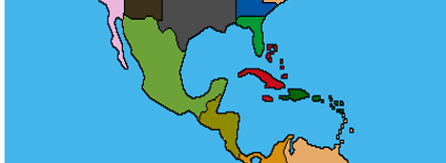
Central America and the Caribbean
This region, known as Landbroen, has also been a victim of European colonisation. After being discovered by viking explorers, this area was eventually colonised by the Spanish and the Byzantines, with the areas being important parts of the respective empires. The collapse of these two empires threw Landbroen into chaos, with the remaining colonialists and the natives of the area.
The Byzantine collapse lead to a period know as the trómos. Most of the Governor’s troops were withdrawn from the region to fight the Turkish attack on Constantinople, leaving the remaining Byzantines in an extremely weak position. Various tribal uprisings led to the Byzantines retreating to the city of New Constantinople, ceding all of their other holdings to the new tribal confederacy united by the Mayans. Over time, this confederacy expanded outside of the original Byzantine territory, incorporating new tribes. It now consists of over 100 tribes, all of whom are represented in the Grand Council of the Mayan Confederacy.
To the north of the Confederacy is Mexico. This area used to be owned by the Spanish Empire, itself part of the Hapsburg Empire. Mexico was part of the Empire ruled by the heir to Spain itself, with the title of Prince of Mexico being given to the first child of the King of Spain. After the Dutch Revolt, Prince Philip of Mexico declared Mexico an independent kingdom, becoming the Kingdom of Mexico. Despite being a Kingdom, Philip never declared himself King instead deciding to remain Prince of Mexico. This became the way of the Kingdom of Mexico, with the head of state being the Prince, not the King.
Mexico has had a unstable history. As one of the last remaining Habsburg-led countries, many unlanded Habsburgs have attempted to claim the throne. Often, the Dutch or Hungarians fund these claimants to the throne, with the most recent (Alfonso of Castille) being funded by both of these countries. Unlanded Habsburgs often find common cause with the many of the native tribes of Mexico, who also wish to get rid of the Princes. Tribal insurgencies and pretenders have hampered the progress of this country, stopping it from expanding its influence outside of its borders.
The Caribbean is entirely owned by three European powers: England, Portugal, and the Dutch Empire. Wars are often fought between the three over ownership of these islands, as the plantations of the Caribbean produce many valuable crops. Sugar, cocoa, and tobacco are all shipped from the plantations of these islands to the markets of Antwerp, Lisbon, and London. The mass use of slaves on these plantations has led to more frequent slave uprisings, particularly on the islands of Cuba and Hispaniola.
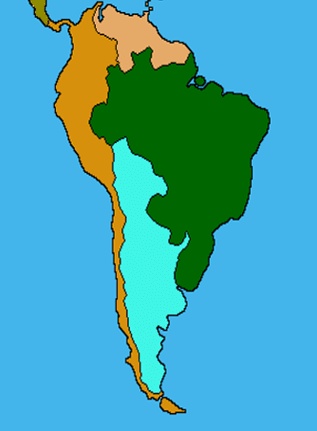
South America
While this continent has been touched by colonialism, the Europeans have been driven out of the south of South America (Skovland).
After the signing of the Treaty of Heinrichstadt, european empires had to look further south to find new places to colonise. Danish explorers discovered a land of endless forests, naming it appropriately. Despite discovering the continent, the Danish never claimed any of Skovland. Instead, Skovland was almost entirely taken by the Habsburg Empire, with a small part being taken by the fledgling Portuguese Empire.
The collapse of the Habsburg Empire led to the division of their lands in Skovland. The newly formed Dutch Empire claimed the northern Habsburg holdings, which already contained a large number of Dutch-majority settlements. This area, which they renamed Ruyschland, acted as an extension of Dutch lands in the Caribbean, with many plantations being set up to farm sugar and coffee. A large number of Dutch soldiers originate from Ruyschland, with the Royal Guard being made up of people from this colony.
The fall of one empire gave another a chance to rise. Many wars took place between the Habsburg Empire and the Inca Empire. Portuguese and Danish support for the Incas allowed the native empire to hold back the Habsburg, with the tides beginning to turn after the 1507 Second Andean War. In order to fund this war, the level of taxation on the Seventeen Provinces of the Netherlands was increased. This increased taxation was the final straw for the people of the Netherlands, and was one of the factors which led to the Dutch Revolt. The revolt gave the Incas the chance to permanently push the Habsburgs out of the Andes, finally achieving this in the 1544 Kuntisuyu War.
The remaining Habsburg colonists, most of whom were of Spanish decent, formed the Republic of Argentina. This republic endured a lot in the first few decades of its existence. Shortly after the signing of its constitution in 1539, the Inca Empire invaded the Argentine holdings in the Andes, forcing them out of the mountains, and leaving them in a weak position. Inca expansions continued throughout the sixteenth century, stopping the Argentines from accessing the sea in the east and the south. Increased taxation was required to fund the defence of the republic, leading to electoral success of native secessionist and monarchist parties, as well as tax revolts in several regions of the country.
Most of Argentina’s problems come from their neighbour to the north: Portuguese Brazil. Initially, this colony was small, with a few towns being founded near to the mouth of the Amazon river. As slavery became more popular, more and more plantations were created on the Brazilian coast. The collapse of the Habsburg Empire led to expansion away from the Amazon river, claiming more and more of the Habsburg land. The foundation of the Republic of Argentina temporally halted these advances, but the attacks from the Inca encouraged the Portuguese to do the same, taking large amounts of northern Argentina.
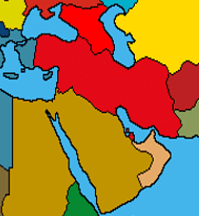
The Middle East and Caucasia
Historically, this region has experienced much turmoil. The majority of the area used to be part of the Byzantine Empire, but the collapse of the Byzantine Empire created a power vacuum. This weakness has been exploited by European powers, with the expansion several empires into this region.
The Ottoman Empire, which controls most of Anatolia, took over much of the Byzantine lands following their collapse. The Empire rose out of a Turkish revolt against their Byzantine overlords, and initially saw huge success. They took Constantinople in 1453, and then proceeded to expand into the Balkans. After they took over Vienna, a coalition of European Christian states, led by France, Muscovy, and the Papal States, formed to drive the Ottomans out of Europe. By 1600, the Ottomans held almost no land in Europe, and the new Christian Greek Empire had been set up by the coalition. The Greek Empire’s push didn’t end with the capture of Constantinople (renamed Istanbul by the Greeks). By 1850, Greek territory in the Middle East extended almost as far as Ankara, with the Ottoman islands of Cyprus and Crete also having been seized.
The Arabian Peninsula also used to be part of the Ottoman Empire, but this all changed following the Arab revolt of 1688. This event saw the Emirate of Hejaz leading many tribes of the peninsula in a rebellion against the Turkish Ottomans. The Ottomans were unable to put down this revolt, as they lacked the forces to deal with the revolt in the south as well as the Greek attacks from the west. In order to be able to slow the Greek advance the Ottomans agreed to give the revolting Arabs independence.
Despite this, not every group of the Arabian Peninsula wanted to join this new pan-Arab state. The Sultanate of Oman refused to join the new pan-Arab state, which led to the first Arab-Omani War (1692-4). The Omanis were almost completely defeated, but the tide of the war changed after they asked the Dutch Empire (who owned several trading posts in Oman) to defend them. Oman became a Dutch protectorate, and the Dutch Empire joined the war. The war ended with Oman annexing some Arab lands, instead of being annexed themselves. Since then, Oman has been incorporated into the Dutch Empire, with the Dutch Ambassador being almost as powerful as the Sultan of Oman.
Caucasia has been united into one state. Once upon a time, this region was partially owned by the Ottomans, but the troubles of the seventeenth century allowed the habitants of the region to rebel, leading to the foundation of the states of Armenia and Azerbaijan. For around fifty years, all three states coexisted. This lasted until around the 1730s, when Muscovy tried to invade Georgia and Armenia. While they managed to fend off these invasions, the threat of Muscovy remained. To combat this threat, the two countries entered into a political union, with a parliament shared by both states. This union left Azerbaijan isolated, and at threat of invasion from the Ottomans who, while weakened, still had a much larger military than Azerbaijan. To protect themselves from the Ottomans, Azerbaijan agreed to join the union of Georgia and Armenia, which was renamed the Transcaucasian Union.
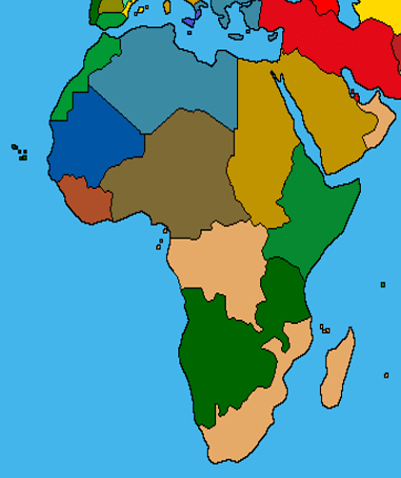
Africa
The Scramble for Africa ended relatively recently, following the 1803 Treaty of Antwerp. Initially, European powers ignored Africa, preferring to focus their energies on securing their colonies in the Americas. A few trading posts were set up on the coast, to allow for trade with the various nations of Africa. The advent of the transatlantic slave trade gave the European empires a reason to expand into the continent, and the instability caused by the slave trade made this much easier for them. African nations were slowly swallowed up, with their fate finally being decided by the Treaty of Antwerp. This treaty divided the continent up between six European powers, guaranteed the independence of the two ‘civilised African nations’, and formalised the incorporation of the Sultanate of Egypt into the Arab Union.
Southern Africa was divided between two states by the treaty: Portugal and the Dutch Empire. The island of Madagascar, South Africa, and the Congo were all given to the Dutch. Originally, South Africa and the Congo were unified in one colony known as Zuid-Afrika. This, however, caused tensions between the Dutch and the Portuguese, with the two empires almost being at war by 1813. In order to avoid war, the six European powers agreed to a peaceful alteration of the borders, with the two Portuguese colonies of Zanzibar and Angola being linked. The peaceful land transfer set a new precedent for colonial diplomacy between the European powers, with the foundation of the African council in Antwerp to deal with disputes between the six powers. The Arab Union was later invited to this council.
The Dutch Congo borders both of the free African states: Ethiopia and the Second Mali Empire. Even before the colonisation of Africa, Ethiopia was a Christian state. Because of this, they have received near consistant support from European Christian nations. The Muslim Egyptians have attempted on multiple occasions to annex parts of Ethiopia, but support from the Papal states, Greece, and France has prevented them from making any real gains. Not only did the the Treaty of Antwerp formally protect the independence of Ethiopia, it also gave them some of the Egyptian land to the north.
The Second Mali Empire was formed shortly after the transatlantic slave trade took off. A group of warlords used the weapons they were given by the Europeans to conquer surrounding tribes and countries, building their own empire. In the year 1705, a warlord declared themself Mansa Suleyman II. Despite initial opposition, they had control of most of the Malian lands. Suleyman II’s decedents ruled the empire until a military coup in 1800 installed Mahmud VI as Mansa. This coup was funded by the Dutch, therefore the new Mansa was very pro-Dutch Empire. He allowed Dutch Traders into the Empire, as well as not opposing the Dutch annexation of several Malian islands.
The north is split between three countries: Greece, Andelucia, and the Arab Union. Andelucian lands were once the independent Sultanate of Morocco, which was conquered by the Andelucians in 1774. The land is still ruled by its Sultan, who is a vassal of Andalusia. To the east of Morocco are the Greek lands. After the Greek Empire had retaken Istanbul, they switched their focus from attacking the Ottomans to conquering North Africa. Several Greek invasions of North African countries were periodically launched between 1600 and 1700, with all the lands between then-Ottoman controlled Egypt and the Sultanate of Morocco being controlled by the Greeks.
Before the Treaty of Antwerp, Egypt had been an independent Sultanate. Having broken free from Ottoman rule following the Greek crusades against the Ottoman Empire, the Sultanate was able to thrive. They conquered several surrounding nations, until they bordered Ethiopia, which is where the Egyptian advance was stopped. In 1742, the Egyptians attempted to form an alliance with the Second Mali Empire, to try and weaken the Christian state which threatened them both. Initially, this alliance was successful, with the Ethiopians being driven out of Sudan; however, this success attracted the attention of several European powers. They sent huge amounts of support to Ethiopia, as well as bribing Mali to leave the war. This was enough to halt the Egyptian advance, with the new border being formalised by the Treaty of Addis Ababa.
The Treaty of Antwerp punished the Egyptians for invading a Christian country. Their Sultan, along with the two other African leaders, was invited to the negotiations, but he had little say in their final outcome. Wanting to show their strength, the European powers gave the Sultan an ultimatum: either renounce the throne, thereby allowing the Sharif of Hejaz to inherit the throne of Egypt, or remain independent and accept huge territorial losses. Unsurprisingly, the Sultan chose the first option. The Sharif of Hejaz, who was also the King of the Arab Union, inherited the throne of Egypt and Egypt was absorbed into the Arab Union.
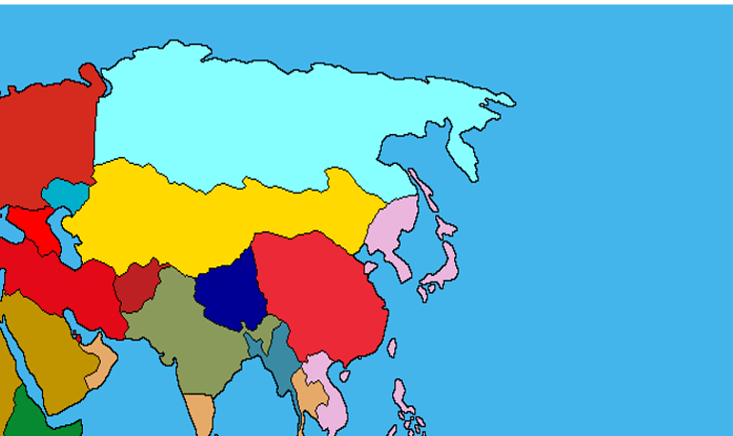
The Far East
For the most part, Asia has remained untouched by European colonialism. Instead, the continent has had to deal with its own empires, the most powerful of which are: the Japanese Empire, the Chinese Empire, and the New Mongol Empire. The arrival of European empires in Asia encouraged faster expansion of the Asian empires.
Japan was unified in 1600, following the victory of the Tokugawa Shogunate at the Battle of Sekighara. The new Japanese government initially pursued an isolationist foreign policy, preferring to focus on improving the Japanese mainland. This isolationist period lasted until 1656, when a Dutch force landed at Kagoshima. The Japanese were able to defeat this Dutch invasion at the battle of Aira. This invasion acted as a wake-up call for the Japanese, reminding them that they were not alone in the world. The victory can be seen as a turning point in Japanese history, forcing them to look beyond their islands. In 1659, Japanese solders were sent abroad for the very first time, as a part of the Japanese invasion of Korea. The success of this invasion inspired further Japanese expansion.
By 1850, Japan had near complete dominance of costal Asia, and its growth shows no signs of slowing. From the Korean peninsula, Japan expanded into Mongol-held Manchuria. The weak Chinese Empire was the Empire’s next target, with the Shandong Peninsula being seized in 1721. While these invasions were taking place, the Empire focused on building up a navy able to rival that of the Dutch. A navy which was tested for the first time during the Second Dutch-Japanese War. The new Japanese navy was able to defeat the Dutch Navy at the Battle of Xisha, determining the outcome of the war. The war ended with the Japanese taking control of several Dutch colonies, including Taiwan, the majority of Dutch Indochina, and the Ma-i islands.
China reunited relatively recently, following the collapse of the Ming Dynasty. The Mongols disposed of Emperor Zhu Youjian, replacing him with their own puppet emperor. The weak rule of the new emperor allowed several regional warlords to break away and form their own Chinas. For a time, China was ruled by seven emperors, each of whom claimed to be the true emperor. This period, known as the Period of Seven Chinas lasted for over 100 years, until one of the warlords was able to win the struggle for China. Five of the seven Chinas were united under the new Chinese Republic, with the other two, Tibet and Manchuria, remaining independent states. This new republic was a republic in the Roman sense: the Emperor was elected by an elite class who resided in Nanjing, the capital, as well as regional rulers. The Emperor is relatively weak, with most power residing with the regional electors.
The Mongol Empire has recently seen a rebirth of sorts. It nearly collapsed after the Siberians rebelled against Mongol rule, but managed to hold on to the Southern parts of their territories. This incident encouraged the Khan to reform the Mongolian military, importing huge numbers of modern, Swiss-made weapons, as well as changing the way in which the military was organised. Thanks to these reforms, the Empire was able to retake central Asia and Manchuria, as well as installing a puppet Emperor in China. The new Khan decided to focus his attentions on conquering Afghanistan and eastern parts of the Ottoman Empire.
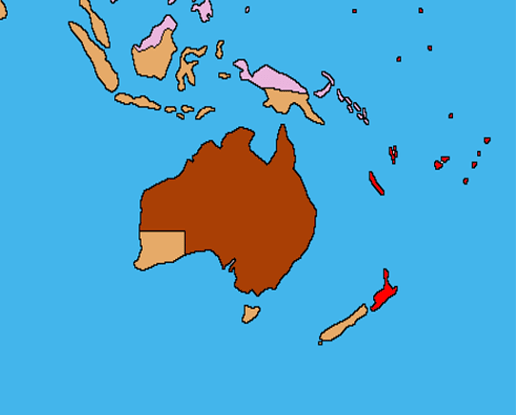
Australasia
For the most part, Australasia is split between two powers: the Dutch and the Japanese. The two powers have fought several wars over various islands in the area, as well as racing to colonise the rest of the continent. However, the natives still control several islands, most notably the majority of Australia.
The Dutch were the first European power to arrive in Australasia, giving them free reign to expand throughout the region. Throughout the sixteenth century, the Dutch established colonies on many islands, with only Australia and the islands to the east of Australia being independent by 1600. The expansion of Japan changed this situation, with the two powers struggling for dominance. The Third Dutch-Japanese War saw territory on the island of Kalimantan being ceded to the Japanese, with the northern half of New Guinea being lost by the Dutch in their forth war.
Competition in the north led to Dutch colonisation of the South of Australasia. The colony of New Holland was founded on the continent of Australia in 1699 by the Dutch explorer Willem de Vlamingh. The town of Nieuw Haarlem was set up to function as the administrative centre of New Holland, where the governor’s palace was built. In 1745 the town was made the capital of Dutch Australia, which comprised of: New Holland, Tasmania, Nieuw Zeeland, the Dutch East Indies, and Dutch Siam. Tasmania and New Holland both act as Dutch penal colonies, with over 75,000 prisoners being shipped to these two colonies to live out their life sentences.
Oh my god, this took so long to write. What started out as a quick post that I could write whilst I worked on the Batman idea turned into a wall of text longer than my history coursework. I hope that it’s interesting to read and not too long a ramble. The maps are also not perfect, but its the first time that I’ve ever designed something like this. I’ll probably keep working on the map, trying to turn it into something that is athletically pleasing instead of just a reference for me. Anyway, back to working on the Batman post.

